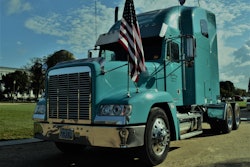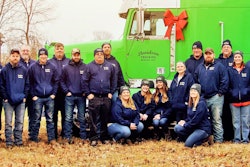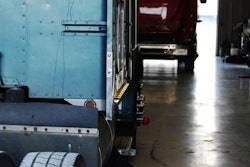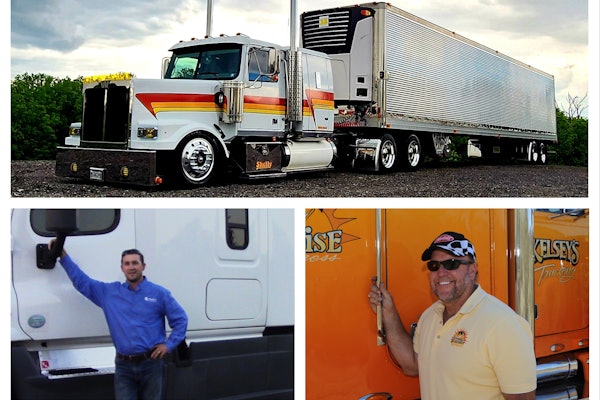The first part in this multipart series, also featured in the March 2019 print edition of Overdrive, detailed the freight relationships that often propel an owner-operator’s expansion to a small fleet. Find it via this link:
Small leased fleet owner-operator Dave Marti and Midnight Xpress owner-operator Andre Jackson, based near Jackson, Mississippi, both employed a common practice as they expanded: limited personal income, separated from business income, from which profits were reinvested. Or, as the case may be, used to cover the unforeseen.
Marti pays himself a set salary that amounts to a “pay cut” from when he ran as a one-truck owner-operator. The remainder of the profit he now separates out in a business account.
Jackson, partnering with Atlanta-based owner-operator Donte Ogletree, launched his authority with more than one truck for the first time in 2017. He learned a valuable lesson when he and Ogletree bought a 2007 Volvo for a third driver last fall.
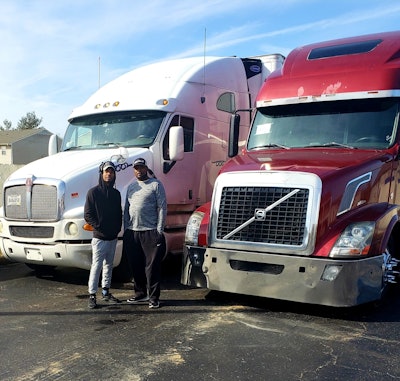 Owner-operators Donte Ogletree (left) and Andre Jackson and two of the three trucks in operation in their young Midnight Xpress fleet near the beginning of the year. Navigating insurance and hiring challenges has presented big barriers to aggressive growth plans.
Owner-operators Donte Ogletree (left) and Andre Jackson and two of the three trucks in operation in their young Midnight Xpress fleet near the beginning of the year. Navigating insurance and hiring challenges has presented big barriers to aggressive growth plans.Before the driver had delivered his second load, a breakdown resulted in an in-frame engine overhaul. Combined with the driver’s departure a couple months later, the experience prompted re-evaluation of their plan for aggressive growth.

Jackson and Ogletree started out paying themselves just $500 weekly each as they ran full-time. They worked with brokers for freight, intending to reinvest profits in extra power units. Even though they were setting aside the equivalent of about 8 cents per mile for a maintenance account, the breakdown tapped out that reserve. They’ve since boosted that escrow rate significantly and begun talks with owner-operators to lease on instead of buying equipment for drivers.
La Crosse, Wisconsin-based owner-operator Rob Hallahan, too, has experienced setbacks. He’s had his authority for about three years but not quite long enough to avoid being considered an “unproven risk” to many insurers.
When he was a solo owner-operator, his insurance agent placed him with Great West for liability at $9,500 annually, Hallahan says. As is common with many insurance carriers when it comes to relatively new carrier authorities, however, Great West wouldn’t cover additional power units when Hallahan wanted to expand in early 2018. That’s when he sold his “Big Orange” 2006 Kenworth W900B to a friend who planned to lease on under Hallahan’s authority. Hallahan bought a newer Kenworth W900L to drive himself.
“Some insurance companies will write the owner-driven single-unit startup and only allow you to maybe add one truck in two years,” says Steve Libertore of National Risk Management Services, an Ohio-based agency. “If you’ve got high aspirations and want to expand quickly, you’re really limited in the insurance companies that will write you.”
Hallahan’s agent moved his policy to Progressive. Interviewed last year, the owner-operator said he had four owner-operator-controlled power units in addition to his own and six trailers insured for required liability coverage, and his trailers and his single owned power unit insured for physical damage.
The cost to him is about $40,000, with the remaining liability covered by the four owner-operators via settlement deductions. Rates vary depending on the owner-operator’s age and driving record. Hallahan covers the first $8,000 for everyone.
Insurance quickly became an issue for the Midnight Xpress owners when they moved to add power units last fall. The high cost of additional coverage was compounded by issues of inexperience when Jackson brought on his brother to replace the driver he’d initially tapped for the Volvo. His aggressive insurance shopping yielded a liability premium of $7,000 down and $3,100 monthly for the young three-unit fleet. That equates to $44,200 annually, nearly $15,000 per truck.
Libertore says such figures aren’t uncommon. A new owner-operator with authority easily could plunk down more than that for liability in the first year. Rates should fall if subsequent years are safe.
Marti has avoided liability insurance issues by remaining leased. His steady-as-she-goes approach to slow growth has allowed him to build reserves for emergencies and, this past year, invest in a six-bay shop with a wash bay in Forrest that also will serve as an operations base.
He “can get six trucks and six trailers in there overnight,” he says. “It’s one of those things that, when you grow, it takes you a while to be able to fund it, but being inside on a cold night,” he expects, will do wonders for promoting his employee drivers’ desire to maintain the truck like they own it.




